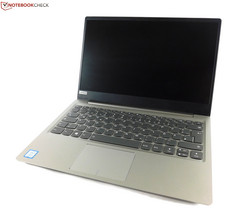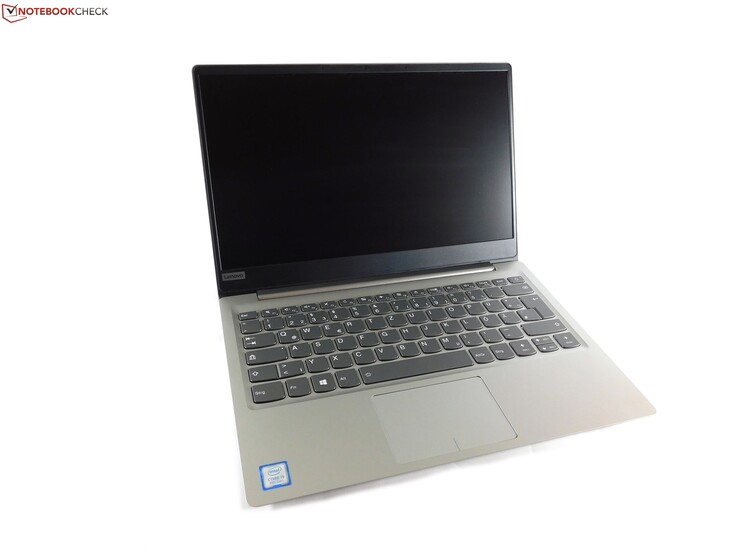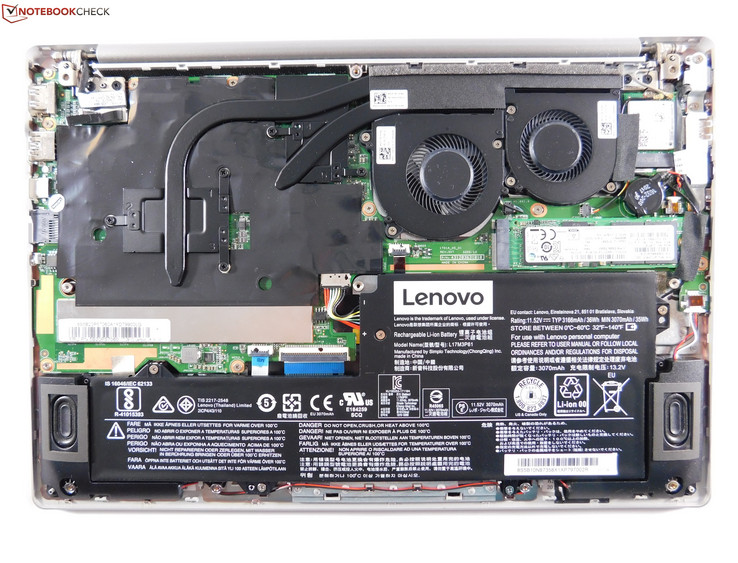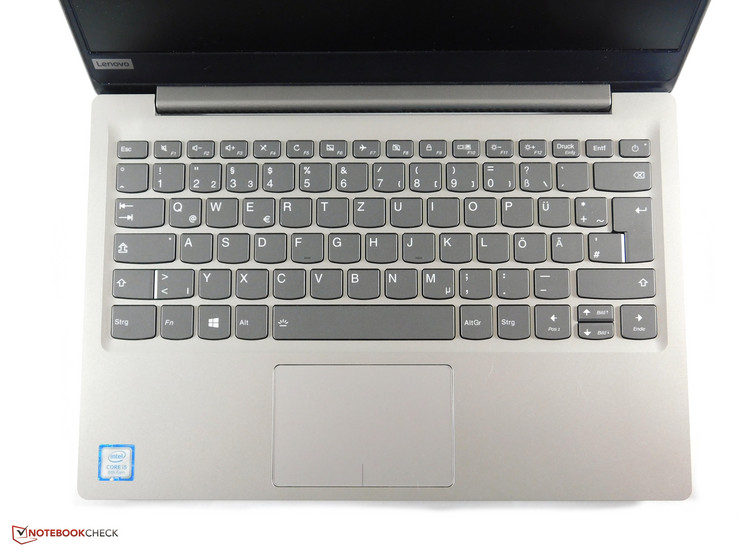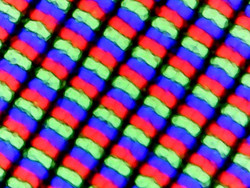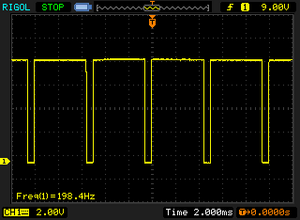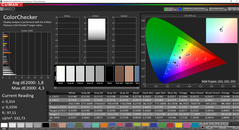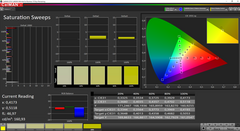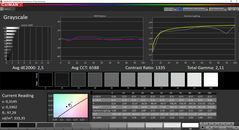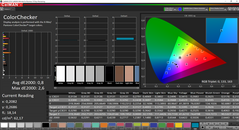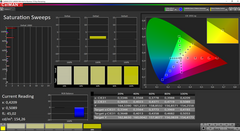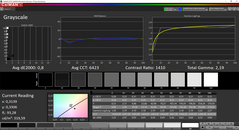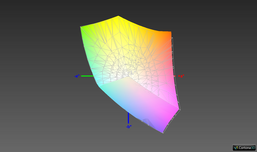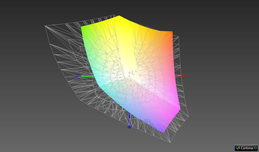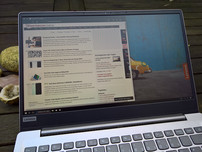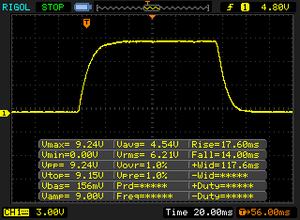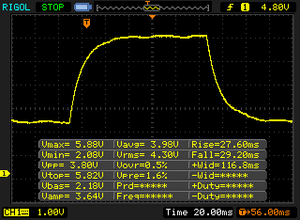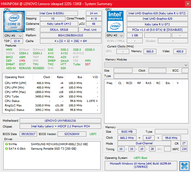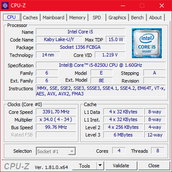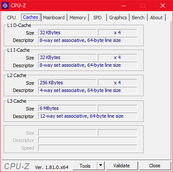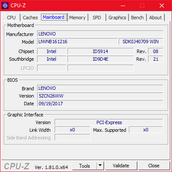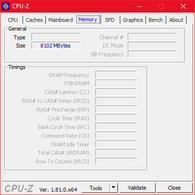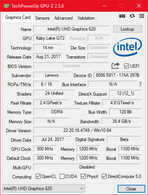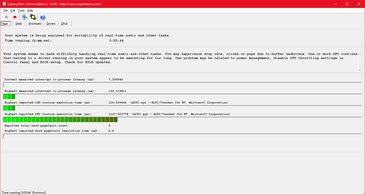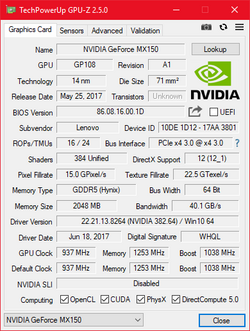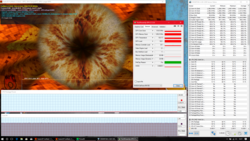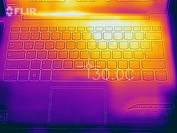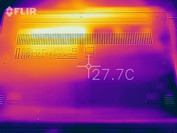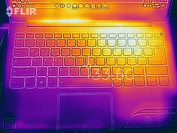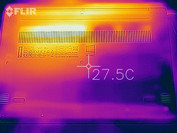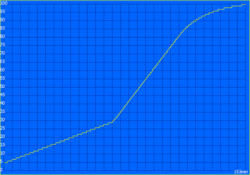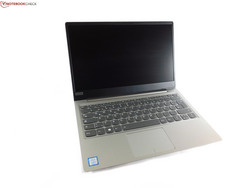Lenovo IdeaPad 320S-13IKBR (i5-8250U, MX150) Laptop Review

Innovations in the world of technology often appear first in the premium segment, while the mass market is considerably more cumbersome. But if the innovation is convincing enough, there can also be movement in the mainstream segment.
Our current test device, the Lenovo IdeaPad 320s-13IKBR, is a fine example of this process of "innovation diffusion" in practice: On the one hand, there are the latest Intel Core i-CPUs of the 8th generation, which were first installed on more expensive notebooks and are now leaking into the middle class. This is also true of Nvidia Pascal: the GPU architecture was introduced in 2016, but it is only this year's release of the GeForce MX 150 that will bring it into the mainstream ultrabook market. The new IdeaPad 320s-13IKBR combines these modern components with a very narrow display frame - another trend that is now finally conquering the mass market.
Our test device, which is a special student version, costs 950 Euros (~$1120). It is not really cheap, but it is still the cheapest 13 to 14-inch notebook with a Kaby-Lake-Refresh processor and GeForce MX150 on the German market. If you can dispense with the MX150, you can have the IdeaPad 320s-13IKBR for about 770 Euros (#$907).
There is no shortage of competition. The most prominent laptop in this class (compact 13.3-inch ultrabook) is the Dell XPS 13, which we were able to test with the latest CPUs. However, the XPS is clearly more expensive, but we will include it in the comparison as a reference point. The Dell Inspiron 13 7370 is more in line with the IdeaPad's price range, whereas the HP Envy 13-ad006ng is a premium ultrabook like XPS 13. The field of competitors is rounded off by the Asus ZenBook UX310UA.
Case
Lenovo's lineup of notebooks for private customers is divided into five classes: 100, 300, 500, 700 and 900. The 900 series is the most expensive and has the best case, the Yoga 920-13IKB, for example, has an aluminium unibody case. The 100 series, on the other hand, is very inexpensive and has to come with a plastic housing.
Our test device is part of the 300 series, the lower mid-range. Accordingly, the lower half of the casing is made entirely of plastic; only the display cover is made of aluminium. This difference between the lid and the base unit is not necessarily visible at first glance, since the palm rest is held in a metallic silver tone, like almost the entire housing. The only exception to this color scheme is the keyboard and the display frame, both of which are black on the IdeaPad 320s-13IKBR.
Although the wrist-rest and the keyboard pad are stable against punctual pressure, you have to make clear cuts compared to more expensive notebooks. Neither the thin display lid nor the base unit can withstand torsional tests much better, and the display lid is easier to twist. Pressure on the reverse side of the back panel can also have a visible effect on the display panel. The IdeaPad 320s-13IKBR may look very similar to more expensive offshoots like the IdeaPad 710s-13IKB, but qualitatively they are poles apart, both in terms of haptics and stability. At least the case is perfectly finished.
The screen is connected to the base by a single drop-down hinge - a design that has become popular among MacBook users. You cannot open the display with one hand and the hinge wobbles a bit in jerky environments.
Thanks to the narrow display edges, the IdeaPad is very compact for a 13.3-inch notebook, only the XPS 13 is slightly smaller. All models in comparison have narrow display edges, with the exception of the Asus ZenBook UX310UA, which is therefore the largest competitor. In terms of weight, there is no great difference between the counterparts; all of them are in the 1.2 to 1.4 kg (~2.6 to 3.1 lb) range.
Connectivity
The IdeaPad has a very simple connectivity that provides just the essentials. It is a shame that Lenovo has a USB 2.0 port here. This should no longer be the case in 2017. The USB-C port with the transmitting data speed of a USB 3.0 is also a missed opportunity. The USB-C port cannot be used for charging or as a display connection.
The ports on the right side in particular are positioned a bit too close together, which can cause problems if you use several ports at the same time.
SD Cardreader
Nowadays, not many notebooks come with an SD card reader, or only offer a card slot for microSD cards, such as the one in the IdeaPad 320s-13IKBR. This microSD card reader, which we tested with the Toshiba Exceria Pro M501, is fast on average.
| SD Card Reader | |
| average JPG Copy Test (av. of 3 runs) | |
| Dell XPS 13 i5-8250U (Toshiba Exceria Pro SDXC 64 GB UHS-II) | |
| Lenovo IdeaPad 320S-13IKB (Toshiba Exceria Pro M501) | |
| HP Envy 13-ad006ng (Toshiba Exceria Pro SDXC 64 GB UHS-II) | |
| Dell Inspiron 13 7370 (Toshiba Exceria Pro SDXC 64 GB UHS-II) | |
| maximum AS SSD Seq Read Test (1GB) | |
| Dell XPS 13 i5-8250U (Toshiba Exceria Pro SDXC 64 GB UHS-II) | |
| Lenovo IdeaPad 320S-13IKB (Toshiba Exceria Pro M501) | |
| HP Envy 13-ad006ng (Toshiba Exceria Pro SDXC 64 GB UHS-II) | |
| Dell Inspiron 13 7370 (Toshiba Exceria Pro SDXC 64 GB UHS-II) | |
Communication
Matching the budget, Lenovo has not installed a 2x2-WLAN in the test device, but only the 1x1-AC-WLAN card Intel Wireless 3165, which is sufficient for everyday use, but in the benchmarks the limitation is obvious in comparison with the 2x2 Wi-Fi modules.
The webcam is placed above the screen, unlike the Dell XPS 13, for example. But this is only a small comfort for the otherwise poor quality of the webcam. Both the webcam and the integrated microphones are just good enough for video telephony.
| Networking | |
| iperf3 transmit AX12 | |
| Dell Inspiron 13 7370 | |
| HP Envy 13-ad006ng | |
| Dell XPS 13 i5-8250U | |
| Lenovo IdeaPad 320S-13IKB | |
| iperf3 receive AX12 | |
| Dell XPS 13 i5-8250U | |
| HP Envy 13-ad006ng | |
| Dell Inspiron 13 7370 | |
| Lenovo IdeaPad 320S-13IKB | |
Accessories
No accessories are included with the notebook and Lenovo does not offer any model-specific accessories for the IdeaPad.
Maintenance
As with many ultrabooks, the IdeaPad 320s requires that you remove the entire base plate to reach the components. Inexplicably, Lenovo has decided to use Torx screws instead of Phillips screws - a pity, since almost everyone owns screwdrivers, Torx screwdrivers, not so much. After removing the TX5 screws you have to loosen the plastic clips around the edge of the plate. This works best without force, with a Spudger-Tool and some patience. Inexperienced and technically unskilled individuals should seek help, as otherwise they can damage the casing.
Once these hurdles have been overcome, one has access to the interior. The M. 2-SSD is easy to replace and upgrade. The situation is different with the RAM, which is unfortunately soldered. Since access to both the battery and the cooling system is important, it is fortunate that these are only screwed in and therefore easy to remove or replace. The cooling system consists of two small fans with two short aluminum heatpipes.
Warranty
A two-year warranty with bring-in service is the standard for many notebooks, including the IdeaPad 320s-13IKBR.
Please see our Guarantees, Return Policies and Warranties FAQ for country-specific information.
Input Devices
Keyboard
The keyboard of our test device corresponds to the so-called Lenovo-AccuType keyboard. Lenovo has been using this chiclet-style keyboard in its current form for its private customers' notebooks for about 5 years in a barely modified form. Typical are the rounded, slightly concave keys, which may look like the keys of a ThinkPad keyboard, but do not match their quality. The stroke is too short and the pressure point not defined enough, but the keyboard is not abysmal.
As with all IdeaPads of the 2017 generation, Lenovo has changed the layout slightly and shrunk the vertical arrow keys, but enlarged the right Shift key. The keyboard has a white, two-stage backlight.
Touchpad
The Touchpad is a precision one according to the Microsoft standard. Consequently, you cannot say anything negative about driver performance. The Touchpad accepts all inputs precisely and correctly, even multitouch gestures.
Touchpad hardware: Lenovo uses a standard ClickPad with integrated buttons that can only be clicked in the lower area. The mechanism produces audible clicks. The surface of the ClickPad is made of plastic and is sufficiently smooth. In summary, the TouchPad convinces us.
Display
All variants of the IdeaPad 320s-13IKBR, whether they cost 600 or 1000 Euros (~$710 or ~$1180), have a 13.3-inch display with a resolution of 1920x1080 (full HD) at the factory setting. This screen is also always a matte IPS panel.
The LCD panel is from the lesser known manufacturer InfoVision, in short, IVO. Lenovo has done a lot right in terms of the choice of this display: it offers both a comparatively high brightness of 304 cd/m² on average and a high contrast value of 1320:1, which most of the more expensive competitors do not surpass. It also has hardly any backlight bleeding and the brightness distribution is uniform enough at 88%. We only have to criticize one drawback: the low PWM frequency of just under 200 Hz, which occurs at less than 100% brightness. For sensitive people this can quickly mean headaches.
| |||||||||||||||||||||||||
Brightness Distribution: 88 %
Center on Battery: 328 cd/m²
Contrast: 1320:1 (Black: 0.25 cd/m²)
ΔE ColorChecker Calman: 1.8 | ∀{0.5-29.43 Ø4.78}
ΔE Greyscale Calman: 2.5 | ∀{0.09-98 Ø5}
97.3% sRGB (Argyll 1.6.3 3D)
61.8% AdobeRGB 1998 (Argyll 1.6.3 3D)
68.1% AdobeRGB 1998 (Argyll 3D)
97.4% sRGB (Argyll 3D)
66.3% Display P3 (Argyll 3D)
Gamma: 2.11
CCT: 6588 K
| Lenovo IdeaPad 320S-13IKB InfoVision M133NWF4R0, , 1920x1080, 13.3" | Dell XPS 13 i5-8250U ID: Sharp SHP144A, Name: LQ133Z1, , 3200x1800, 13.3" | Dell Inspiron 13 7370 BOE071A / NV13FHM / Dell G64PY, , 1920x1080, 13.3" | HP Envy 13-ad006ng BOE070E, , 1920x1080, 13.3" | Asus Zenbook UX310UA-FC347T iGP AU Optronics AUO272D, , 1920x1080, 13.3" | |
|---|---|---|---|---|---|
| Display | -5% | -6% | -6% | -13% | |
| Display P3 Coverage (%) | 66.3 | 63.9 -4% | 66.7 1% | 66.8 1% | 64.2 -3% |
| sRGB Coverage (%) | 97.4 | 91.7 -6% | 86.2 -11% | 86.3 -11% | 65.3 -33% |
| AdobeRGB 1998 Coverage (%) | 68.1 | 65.7 -4% | 63 -7% | 63.1 -7% | 65.3 -4% |
| Response Times | 27% | 8% | 7% | 30% | |
| Response Time Grey 50% / Grey 80% * (ms) | 56.8 ? | 29 ? 49% | 46 ? 19% | 48 ? 15% | 40 ? 30% |
| Response Time Black / White * (ms) | 31.6 ? | 30 ? 5% | 33 ? -4% | 32 ? -1% | 22 ? 30% |
| PWM Frequency (Hz) | 198.4 ? | 19500 ? | 201 ? | 1000 ? | 200 ? |
| Screen | -47% | -53% | -49% | -46% | |
| Brightness middle (cd/m²) | 330 | 361 9% | 301 -9% | 281 -15% | 358 8% |
| Brightness (cd/m²) | 304 | 303 0% | 291 -4% | 264 -13% | 347 14% |
| Brightness Distribution (%) | 88 | 72 -18% | 87 -1% | 83 -6% | 87 -1% |
| Black Level * (cd/m²) | 0.25 | 0.33 -32% | 0.33 -32% | 0.23 8% | 0.26 -4% |
| Contrast (:1) | 1320 | 1094 -17% | 912 -31% | 1222 -7% | 1377 4% |
| Colorchecker dE 2000 * | 1.8 | 5.26 -192% | 5.39 -199% | 4.83 -168% | 5.22 -190% |
| Colorchecker dE 2000 max. * | 4.3 | 7.79 -81% | 8.56 -99% | 8.89 -107% | 9.19 -114% |
| Greyscale dE 2000 * | 2.5 | 5.69 -128% | 5.93 -137% | 6.63 -165% | 6.69 -168% |
| Gamma | 2.11 104% | 1.63 135% | 2.6 85% | 1.85 119% | 2.35 94% |
| CCT | 6588 99% | 6499 100% | 6358 102% | 6794 96% | 6745 96% |
| Color Space (Percent of AdobeRGB 1998) (%) | 61.8 | 59 -5% | 56 -9% | 56 -9% | 59 -5% |
| Color Space (Percent of sRGB) (%) | 97.3 | 92 -5% | 86 -12% | 86 -12% | 91 -6% |
| Total Average (Program / Settings) | -8% /
-29% | -17% /
-36% | -16% /
-33% | -10% /
-29% |
* ... smaller is better
Screen Flickering / PWM (Pulse-Width Modulation)
| Screen flickering / PWM detected | 198.4 Hz | ≤ 99 % brightness setting | |
The display backlight flickers at 198.4 Hz (worst case, e.g., utilizing PWM) Flickering detected at a brightness setting of 99 % and below. There should be no flickering or PWM above this brightness setting. The frequency of 198.4 Hz is relatively low, so sensitive users will likely notice flickering and experience eyestrain at the stated brightness setting and below. In comparison: 53 % of all tested devices do not use PWM to dim the display. If PWM was detected, an average of 8108 (minimum: 5 - maximum: 343500) Hz was measured. | |||
Even without calibration, the screen provides a good color display. Calibration with the ICC profile created by us improves the color values only slightly. Subjectively, it is a good display with sharp image and natural colors.
The good color representation can also be attributed to the high color space coverage. 97.3% of the sRGB color space is a good value, which even many more expensive notebooks often fail to achieve. Thus, the IdeaPad is even suitable for semi-professional image processing, even if the notebook itself is certainly not aimed at this target group.
Display Response Times
| ↔ Response Time Black to White | ||
|---|---|---|
| 31.6 ms ... rise ↗ and fall ↘ combined | ↗ 17.6 ms rise | |
| ↘ 14 ms fall | ||
| The screen shows slow response rates in our tests and will be unsatisfactory for gamers. In comparison, all tested devices range from 0.1 (minimum) to 240 (maximum) ms. » 85 % of all devices are better. This means that the measured response time is worse than the average of all tested devices (20.2 ms). | ||
| ↔ Response Time 50% Grey to 80% Grey | ||
| 56.8 ms ... rise ↗ and fall ↘ combined | ↗ 27.6 ms rise | |
| ↘ 29.2 ms fall | ||
| The screen shows slow response rates in our tests and will be unsatisfactory for gamers. In comparison, all tested devices range from 0.165 (minimum) to 636 (maximum) ms. » 93 % of all devices are better. This means that the measured response time is worse than the average of all tested devices (31.6 ms). | ||
Typical IPS: There is practically nothing to complain about the viewing angle stability, as unlike the TN screens, the colors do not invert. A loss of brightness or contrast can be observed at extreme viewing angles, but this is hardly disturbing during normal operation.
Performance
A total of five different models of the IdeaPad 320s-13IKB and 320s-13IKBR are listed at various dealerships. The cheapest configuration for 600 Euros (~$710) stands out clearly from the crowd, as it is the only one with 4 GB of memory, 128 GB SSD space, a golden case and the Intel Core i3-7100U. All other models have a silver case and 8 GB (DDR4-2133 RAM) of soldered memory. Options are available for the CPU, with either the Core i5-8250U or Core i7-8550U, as well as for the SSD. Either 256 or 512 GB SSDs are built in. Our model (81AK0037GE) is the only one with the Nvidia GeForce MX150.
Processor
The Intel Core i5-8250U is a quad-core processor of the Kaby-Lake Refresh generation. As an ultra-low-voltage CPU, it has a maximum power dissipation of 15 watts as standard, whereby the manufacturers can adjust this value. The basic clock rate of the four cores, which offer eight threads thanks to hyperthreading, is 1.6 GHz, while the turbo's speed is 3.4 GHz. Compared to its dual-core predecessor Core i5-7200U, the Core i5-8250U generally achieves a significant increase in performance - this and other comparisons between processors are possible with our CPU benchmark list.
At least in theory the i5-8250U is significantly faster. Up to now, we have mainly tested more expensive notebooks with this processor. Therefore, it is exciting to see how the CPU would perform on a budget device. The result is quite disappointing for us because the CPU is far from its potential performance optimum.
In the Cinebench multicore test, the CPU can consume 25 watts for 30 seconds. That alone is not enough for the maximum clock rate, but rather 45 watts would be necessary. At 25 watts, the processor's four cores run at 2.8 GHz. After 30 seconds, the TDP limit of 15 watts comes into effect and the clock rate drops to 2.2 GHz. Therefore, in the 30-minute Cinebench test, a higher result is achieved in the first pass because the CPU may only consume 25 watts at the beginning. In addition to this TDP limitation, however, the manufacturer has also set a temperature limitation of 75 °C (~167 °F). Once this value is reached, the clock rate drops to 1.5 GHz and the CPU may only consume 8 watts. This happened once during the Cinebench loop, which explains the crash to 392 points. Afterwards, the system cools down again and then it is allowed to consume 15 watts again.
The 75 °C (~167 °F) limit also affects the single-core score, which is therefore lower than for the Dell XPS 13 with the same CPU, for example. All in all, the IdeaPad simply cannot get the full performance of the CPU, either under continuous load or in short boosts. Even under continuous load, the XPS 13 achieves a higher result (about 520 points) than the IdeaPad 320s-13IKBR in a single multicore test. If the system is loaded, it can also be possible for the 75 °C (~167 °F) limit to come into effect, which means that little more power is available than with a last-generation i7 dual-core processor. At least the i5-8250U's direct predecessor, the i5-7200U, will definitely be beaten.
In battery operation, the CPU power is not throttled.
System Performance
In both variants of the PCMark 8, the test device ranks in the middle of the field, although the differences are mostly marginal. Only the XPS 13 is significantly weaker, presumably due to the higher-resolution display. In everyday life, the IdeaPad is very fast and without noticeable pauses.
| PCMark 8 | |
| Home Score Accelerated v2 | |
| Asus Zenbook UX310UA-FC347T iGP | |
| Dell Inspiron 13 7370 | |
| Lenovo IdeaPad 320S-13IKB | |
| HP Envy 13-ad006ng | |
| Dell XPS 13 i5-8250U | |
| Work Score Accelerated v2 | |
| Asus Zenbook UX310UA-FC347T iGP | |
| HP Envy 13-ad006ng | |
| Lenovo IdeaPad 320S-13IKB | |
| Dell Inspiron 13 7370 | |
| Dell XPS 13 i5-8250U | |
| PCMark 10 | |
| Productivity | |
| Lenovo IdeaPad 320S-13IKB | |
| HP Envy 13-ad006ng | |
| Score | |
| HP Envy 13-ad006ng | |
| Lenovo IdeaPad 320S-13IKB | |
| PCMark 8 Home Score Accelerated v2 | 3796 points | |
| PCMark 8 Work Score Accelerated v2 | 4826 points | |
| PCMark 10 Score | 3191 points | |
Help | ||
Storage Devices
In many respects Lenovo has saved money, but not on the SSD. This one is from Samsung, has a capacity of 512 GB and carries the model number PM961. The PM961 is a PCIe NVMe and one of the better SSDs of this type, which is also reflected in the benchmarks. Compare with other SSDs and HDDs in our SSD/HDD list.
| Lenovo IdeaPad 320S-13IKB Samsung PM961 NVMe MZVLW512HMJP | Dell XPS 13 i5-8250U Toshiba XG5 KXG50ZNV256G | Dell Inspiron 13 7370 Micron 1100 MTFDDAV256TBN | HP Envy 13-ad006ng Toshiba NVMe THNSN5256GPUK | Asus Zenbook UX310UA-FC347T iGP Micron SSD 1100 (MTFDDAV256TBN) | |
|---|---|---|---|---|---|
| CrystalDiskMark 3.0 | -41% | -60% | -41% | -51% | |
| Write 4k QD32 (MB/s) | 475 | 345.8 -27% | 160.3 -66% | 161.3 -66% | 251.5 -47% |
| Read 4k QD32 (MB/s) | 537 | 365.5 -32% | 172.8 -68% | 494.6 -8% | 246.3 -54% |
| Write 4k (MB/s) | 142.6 | 115.6 -19% | 65.8 -54% | 109.4 -23% | 88.7 -38% |
| Read 4k (MB/s) | 56.8 | 26.67 -53% | 20.79 -63% | 34.5 -39% | 26.68 -53% |
| Write 512 (MB/s) | 636 | 265.7 -58% | 298.2 -53% | 172.3 -73% | 389.1 -39% |
| Read 512 (MB/s) | 821 | 443.9 -46% | 351 -57% | 735 -10% | 356.7 -57% |
| Write Seq (MB/s) | 1010 | 337.4 -67% | 458.3 -55% | 195.4 -81% | 431.6 -57% |
| Read Seq (MB/s) | 1372 | 1046 -24% | 476.8 -65% | 1019 -26% | 489.4 -64% |
Graphics
The Nvidia GeForce MX150 is a low-end graphics solution of the Pascal GPU architecture - currently the only low-end GPU of the Pascal generation. It was released in the middle of this year as a long overdue replacement for the old GeForce 940MX, which is usually much faster than this one, as can be seen in our GPU benchmark list.
However, in the IdeaPad 320s-13IKBR, the MX150, as with the CPU, is far from its maximum performance potential. Moreover, it only achieves the same performance as the GeForce 940MX in the GDDR5 version. At this point one should ask oneself: Why invest money in the newer hardware if it delivers the same performance as its predecessor?
The same power is available in battery operation as with the connected power supply unit.
| 3DMark 11 - 1280x720 Performance GPU | |
| HP Envy 13-ad006ng | |
| Lenovo ThinkPad 25 | |
| Lenovo IdeaPad 320S-13IKB | |
| Dell Inspiron 13 7370 | |
| Dell XPS 13 i5-8250U | |
| Asus Zenbook UX310UA-FC347T iGP | |
| 3DMark | |
| 1280x720 Cloud Gate Standard Graphics | |
| HP Envy 13-ad006ng | |
| Lenovo IdeaPad 320S-13IKB | |
| Lenovo ThinkPad 25 | |
| Dell Inspiron 13 7370 | |
| Asus Zenbook UX310UA-FC347T iGP | |
| Dell XPS 13 i5-8250U | |
| 1920x1080 Fire Strike Graphics | |
| HP Envy 13-ad006ng | |
| Lenovo ThinkPad 25 | |
| Lenovo IdeaPad 320S-13IKB | |
| Dell Inspiron 13 7370 | |
| Asus Zenbook UX310UA-FC347T iGP | |
| 3DMark 11 Performance | 3028 points | |
| 3DMark Cloud Gate Standard Score | 8464 points | |
| 3DMark Fire Strike Score | 2100 points | |
Help | ||
Gaming Performance
As with the CPU loop, we perform a comparable load test on dedicated GPUs, in this case with the game “Witcher 3” at the detail level "Ultra". As with the CPU, the GPU is unable to maintain its maximum performance for a long run, and at the beginning of the test a higher FPS number is reached than further in the course.
The MX150 is certainly not a GPU that would be built into a real gaming laptop. Even though it is based on modern architecture, it is still a low-end GPU. For casual gamers, however, it is actually quite adequate. It is roughly on the level of the older GeForce GTX 950M, which is able to display many newer games at least in medium details and full HD. But this requires sufficient cooling. The MX150 in the IdeaPad performs very poorly and even falls behind the GeForce 940MX in the Lenovo ThinkPad 25. The game tests thus reflect the results of the 3DMark benchmarks.
| The Witcher 3 - 1366x768 Medium Graphics & Postprocessing | |
| Microsoft Surface Book 2 | |
| Acer Aspire F5-771G-50RD | |
| Xiaomi Mi Notebook Pro i5 | |
| HP Envy 13-ad006ng | |
| Lenovo ThinkPad 25 | |
| Lenovo IdeaPad 320S-13IKB | |
| Asus Zenbook UX310UA-FC347T iGP | |
| Rise of the Tomb Raider - 1366x768 Medium Preset AF:2x | |
| Microsoft Surface Book 2 | |
| Acer Aspire F5-771G-50RD | |
| Xiaomi Mi Notebook Pro i5 | |
| HP Envy 13-ad006ng | |
| Lenovo ThinkPad 25 | |
| Lenovo IdeaPad 320S-13IKB | |
| Dell XPS 13 i5-8250U | |
| low | med. | high | ultra | |
|---|---|---|---|---|
| Company of Heroes 2 (2013) | 45.92 | 35.16 | 20.32 | 7.87 |
| The Witcher 3 (2015) | 44.73 | 24.44 | 13.31 | 6.5 |
| Rise of the Tomb Raider (2016) | 47.33 | 28.15 | 14.83 |
Emissions
System noise
Although the components could actually be quite powerful, Lenovo lets the two small fans run only quietly and rarely - while idling, they are completely switched off. They run under load, but are often still very restrained. It would probably be better if the fans were to run a little more vigorously under load so that the system could really deliver the promised performance. Lenovo should improve this.
We could not find any coil whining on the IdeaPad.
Noise level
| Idle |
| 30 / 30 / 30 dB(A) |
| Load |
| 32.2 / 38.8 dB(A) |
 | ||
30 dB silent 40 dB(A) audible 50 dB(A) loud |
||
min: | ||
Temperature
Although as expected, the case does not heat up while idling, the temperatures under load clearly exceed the 40 °C (~104 °F) mark. 47 °C (~117 °F) can be measured at the bottom. The critical 50 °C (~122 °F) mark is not exceeded, but in the long run the use on the lap can become unpleasant under load.
In the stress test with the combination of Prime95 and FurMark, both the graphics chip and the processor are throttling significantly. The CPU clock rate drops immediately to 1.5 GHz and the GPU clock rate to about 520 MHz. With this throttling, the internal temperatures remain within acceptable limits. The CPU reaches a maximum of 72 °C (~162 °F), the GPU 63 °C (~145 °F).
The score of the 3DMark11, which we usually perform directly after the stress test, turned out to be normal. This does not affect the already existing performance limitation of the test device.
(±) The maximum temperature on the upper side is 45 °C / 113 F, compared to the average of 35.9 °C / 97 F, ranging from 21.4 to 59 °C for the class Subnotebook.
(-) The bottom heats up to a maximum of 47 °C / 117 F, compared to the average of 39.3 °C / 103 F
(+) In idle usage, the average temperature for the upper side is 23.5 °C / 74 F, compared to the device average of 30.8 °C / 87 F.
(±) Playing The Witcher 3, the average temperature for the upper side is 32.9 °C / 91 F, compared to the device average of 30.8 °C / 87 F.
(+) The palmrests and touchpad are cooler than skin temperature with a maximum of 27.6 °C / 81.7 F and are therefore cool to the touch.
(±) The average temperature of the palmrest area of similar devices was 28.2 °C / 82.8 F (+0.6 °C / 1.1 F).
Speakers
Although the IdeaPad is primarily a subnotebook, it is also a laptop with multimedia focus. The stereo speakers on the bottom of the laptop are quite weak. While there are quieter loudspeakers, the quality of the sound output is very poor, whether it is treble or base.
The combined headphone and microphone connection functions much better.
Lenovo IdeaPad 320S-13IKB audio analysis
(±) | speaker loudness is average but good (74.5 dB)
Bass 100 - 315 Hz
(±) | reduced bass - on average 14.9% lower than median
(±) | linearity of bass is average (9.2% delta to prev. frequency)
Mids 400 - 2000 Hz
(±) | higher mids - on average 8.3% higher than median
(±) | linearity of mids is average (11.4% delta to prev. frequency)
Highs 2 - 16 kHz
(±) | higher highs - on average 6.7% higher than median
(±) | linearity of highs is average (7.9% delta to prev. frequency)
Overall 100 - 16.000 Hz
(±) | linearity of overall sound is average (29.9% difference to median)
Compared to same class
» 92% of all tested devices in this class were better, 1% similar, 7% worse
» The best had a delta of 5%, average was 18%, worst was 53%
Compared to all devices tested
» 88% of all tested devices were better, 3% similar, 10% worse
» The best had a delta of 4%, average was 24%, worst was 134%
HP Envy 13-ad006ng audio analysis
(-) | not very loud speakers (70.1 dB)
Bass 100 - 315 Hz
(-) | nearly no bass - on average 27.6% lower than median
(±) | linearity of bass is average (9.8% delta to prev. frequency)
Mids 400 - 2000 Hz
(+) | balanced mids - only 2.2% away from median
(+) | mids are linear (6.1% delta to prev. frequency)
Highs 2 - 16 kHz
(+) | balanced highs - only 2% away from median
(+) | highs are linear (3.7% delta to prev. frequency)
Overall 100 - 16.000 Hz
(±) | linearity of overall sound is average (20.2% difference to median)
Compared to same class
» 63% of all tested devices in this class were better, 9% similar, 28% worse
» The best had a delta of 5%, average was 18%, worst was 53%
Compared to all devices tested
» 52% of all tested devices were better, 8% similar, 40% worse
» The best had a delta of 4%, average was 24%, worst was 134%
Frequenzdiagramm im Vergleich (Checkboxen oben an-/abwählbar!)
Power Management
Power Consumption
When it comes to energy consumption, the IdeaPad 320s-13IKBR performs very similar to the other comparators. Only at the maximum load the value it consumes becomes considerably more. Of the models with a Core i5-8250U, the test device performs best in idle mode.
For the maximum consumption of 60 watts, which is only a short load peak, the supplied 65-watt power supply unit is just large enough.
| Off / Standby | |
| Idle | |
| Load |
|
Key:
min: | |
| Lenovo IdeaPad 320S-13IKB i5-8250U, GeForce MX150, Samsung PM961 NVMe MZVLW512HMJP, IPS LED, 1920x1080, 13.3" | Dell XPS 13 i5-8250U i5-8250U, UHD Graphics 620, Toshiba XG5 KXG50ZNV256G, IGZO IPS, 3200x1800, 13.3" | Dell Inspiron 13 7370 i5-8250U, UHD Graphics 620, Micron 1100 MTFDDAV256TBN, IPS, 1920x1080, 13.3" | HP Envy 13-ad006ng i7-7500U, GeForce MX150, Toshiba NVMe THNSN5256GPUK, IPS LED, 1920x1080, 13.3" | Asus Zenbook UX310UA-FC347T iGP i7-7500U, HD Graphics 620, Micron SSD 1100 (MTFDDAV256TBN), IPS, LED, 1920x1080, 13.3" | |
|---|---|---|---|---|---|
| Power Consumption | -3% | 5% | 7% | 9% | |
| Idle Minimum * (Watt) | 3.4 | 3.6 -6% | 3.6 -6% | 2.8 18% | 3.5 -3% |
| Idle Average * (Watt) | 6.1 | 7.9 -30% | 6.8 -11% | 5.8 5% | 6.6 -8% |
| Idle Maximum * (Watt) | 7.7 | 8.5 -10% | 8.9 -16% | 7.7 -0% | 7.5 3% |
| Load Average * (Watt) | 44.2 | 43 3% | 36 19% | 48 -9% | 34.7 21% |
| Witcher 3 ultra * (Watt) | 37.6 | 35 7% | |||
| Load Maximum * (Watt) | 60.3 | 43 29% | 36.5 39% | 48 20% | 39.6 34% |
* ... smaller is better
Battery life
The last point where you realize that the IdeaPad is not a "premium notebook" is the battery. Lenovo only grants the test device 36 watt hours, which is very little. However, the Dell Inspiron 13 7370 has a similarly sized battery with 38 watt hours.
Due to the low battery capacity, the results in the battery life tests are not good. The Dell XPS 13 offers twice as long a battery life in the practical WLAN test. The IdeaPad runs out of steam after just five hours and 45 minutes. With a subnotebook, it is a pity that mobile use is so limited.
The charging process takes a relatively long time because the battery is rather small. After two and a half hours the battery is full again.
| Lenovo IdeaPad 320S-13IKB i5-8250U, GeForce MX150, 36 Wh | Dell XPS 13 i5-8250U i5-8250U, UHD Graphics 620, 60 Wh | Dell Inspiron 13 7370 i5-8250U, UHD Graphics 620, 38 Wh | HP Envy 13-ad006ng i7-7500U, GeForce MX150, 51 Wh | Asus Zenbook UX310UA-FC347T iGP i7-7500U, HD Graphics 620, 48 Wh | |
|---|---|---|---|---|---|
| Battery runtime | 83% | 5% | 48% | 44% | |
| Reader / Idle (h) | 12.3 | 18.2 48% | 12.9 5% | 20 63% | 16.1 31% |
| H.264 (h) | 5.8 | 7.9 36% | 6.9 19% | ||
| WiFi v1.3 (h) | 5.7 | 11.5 102% | 5.8 2% | 7.1 25% | 9.6 68% |
| Load (h) | 1.2 | 2.4 100% | 1.3 8% | 2 67% | 1.9 58% |
Verdict
Pros
Cons
The IdeaPad 320s-13IKBR is a tempting offer, but the Lenovo has made significant cuts.
With the Intel Core i5-8250U and the Nvidia GeForce MX150 in such a compact device it is easy to advertise, especially because it is currently the cheapest notebook with this combination of components. The problem: Both the processor and the graphics chip fall far short of expectations. The Core i5-8250U is far from its maximum and can even drop to the level of a last-generation dual-core processor while under load. It is even worse with the GeForce GPU, which works completely at the level of the outdated Maxwell predecessor 940MX. In addition to this performance limitation, the overly small battery is a problem, because what good is an ultra-mobile laptop if you cannot use it for long when on the move. The manufacturer also advertises the fast processor and the relatively good GPU, but they do not deliver the performance you expect.
It is a pity, because the IdeaPad 320s-13IKBR also has its positive aspects. This includes, above all, the very good display, which is plagued by PWM, but is otherwise all around good: brightness of more than 300 cd/m², good contrast values and color gamut of 97% of the sRGB color space. Thanks to its matte surface, the display is easy to read outdoors as well as indoors. In addition to the display, one should also mention the fast SSD and the good TouchPad, which showed no weaknesses in the test. The compact dimensions are also beautiful due to the minimal display edges and the quiet fan. However less good is the fact that Lenovo only has a badly mutilated USB-C port, and just as incomprehensible is the USB 2.0 port. Although the 1x1 WLAN card is not slow in everyday life, it limits the transfer rates considerably.
Low battery life and poor performance: The IdeaPad 320s-13IKBR has too many weaknesses in crucial areas.
In short, the IdeaPad 320s-13IKBR cannot be recommended. It does not perform well enough in the important categories of battery life, CPU and GPU performance, which is too low for 950 Euros (~$1120). Instead, we would rather recommend a look at the HP Envy 13 in the current version with Kaby-Lake-Refresh CPUs and MX150 - or, if you can do without the GPU, the Dell XPS 13.
Lenovo IdeaPad 320S-13IKB
- 12/04/2017 v6 (old)
Benjamin Herzig




